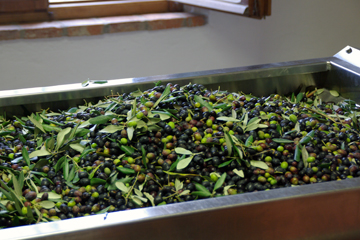
Olive Oil Process
by
Terry Sullivan
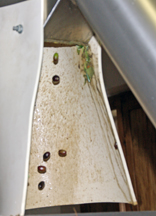 The first step in processing olive oil is usually to weigh the olives then remove the olives from stems, leaves and branches. Crates of olives are dumped into a machine that can separate the olives. A machine, much like a destemmer used in a winery, removes the stems, branches and leaves that fall into one bin. The olives fall into another bin. Depending on the method used to produce oil, the pits may or may not be removed. The first step in processing olive oil is usually to weigh the olives then remove the olives from stems, leaves and branches. Crates of olives are dumped into a machine that can separate the olives. A machine, much like a destemmer used in a winery, removes the stems, branches and leaves that fall into one bin. The olives fall into another bin. Depending on the method used to produce oil, the pits may or may not be removed.
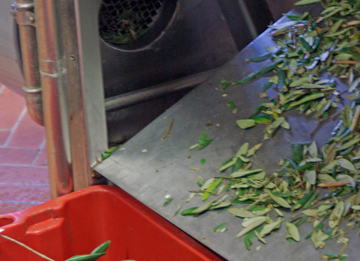
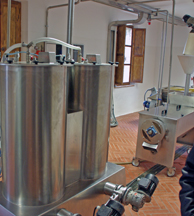 We experienced olive oil processing using the Veronelli method. The pits were removed from the olives. The olives were then placed into a machine. This machine protects the olives from air. Nitrogen passes through the vertical kneading machine at 25 °C (77º F). In 45 minutes the olives are turned into a paste. We experienced olive oil processing using the Veronelli method. The pits were removed from the olives. The olives were then placed into a machine. This machine protects the olives from air. Nitrogen passes through the vertical kneading machine at 25 °C (77º F). In 45 minutes the olives are turned into a paste.
 The last machine is a 2-cycle centrifuge that separates the oil from the natural water that are within the olives. The extracted oil pours out from the bottom of this last machine into a collection bin. The last machine is a 2-cycle centrifuge that separates the oil from the natural water that are within the olives. The extracted oil pours out from the bottom of this last machine into a collection bin.
The extracted olive oil is pumped into stainless steel tanks for storage. Unlike wine, olive oil does not need to ferment or age. It will remain in these tanks until an order is placed for its purchase. Once an order is placed the olive oil will be bottled using a bottling machine.
|
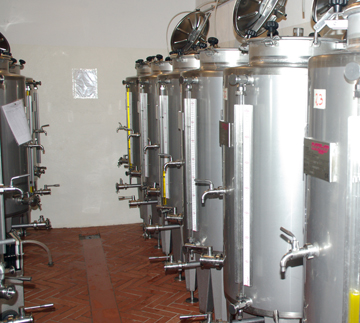
Some olive oil producers extract oil from the pits (pictured below). However this is not permitted if following the Veronelli method. In this case, olive pits are separated from the pulp and collected in a bin. They can then be sold and burned for heat.
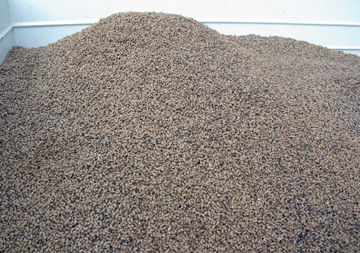
The Veronelli Method Guidelines
1. Identify the variety of olives and keep the harvest of this variety separate from other varieties.
2. Within four hours of harvest, the olives must arrive at the mill.
3. The oil must be processed within four hours at the mill.
4. Provide special labeling.
|


 The first step in processing olive oil is usually to weigh the olives then remove the olives from stems, leaves and branches. Crates of olives are dumped into a machine that can separate the olives. A machine, much like a destemmer used in a winery, removes the stems, branches and leaves that fall into one bin. The olives fall into another bin. Depending on the method used to produce oil, the pits may or may not be removed.
The first step in processing olive oil is usually to weigh the olives then remove the olives from stems, leaves and branches. Crates of olives are dumped into a machine that can separate the olives. A machine, much like a destemmer used in a winery, removes the stems, branches and leaves that fall into one bin. The olives fall into another bin. Depending on the method used to produce oil, the pits may or may not be removed.
 We experienced olive oil processing using the Veronelli method. The pits were removed from the olives. The olives were then placed into a machine. This machine protects the olives from air. Nitrogen passes through the vertical kneading machine at 25 °C (77º F). In 45 minutes the olives are turned into a paste.
We experienced olive oil processing using the Veronelli method. The pits were removed from the olives. The olives were then placed into a machine. This machine protects the olives from air. Nitrogen passes through the vertical kneading machine at 25 °C (77º F). In 45 minutes the olives are turned into a paste.  The last machine is a 2-cycle centrifuge that separates the oil from the natural water that are within the olives. The extracted oil pours out from the bottom of this last machine into a collection bin.
The last machine is a 2-cycle centrifuge that separates the oil from the natural water that are within the olives. The extracted oil pours out from the bottom of this last machine into a collection bin.

